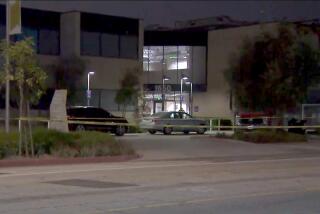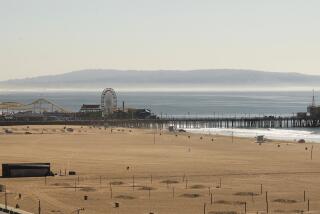Extension of Promenade Proposed
Santa Monica Place, the enclosed mall that borders the thriving Third Street Promenade, would be converted to an open-air district with street-level shops and upper-level office space and housing under a plan under review by Santa Monica city officials.
Both city officials and the mall’s owner, Macerich Co., a Santa Monica real estate investment trust, support the concept. City staff members are drafting a specific plan for the proposal.
Company and city officials said it could be two years before the start of construction, and there are no cost estimates yet.
The ultimate aim, said Mayor Michael Feinstein, is to improve the flow of pedestrians between the Promenade, the Santa Monica Municipal Pier and the soon-to-be-revamped Civic Center to the south and west of the mall.
“The mall is a major impediment, sitting in the middle, blocking full circulation among all of those destinations,” said Feinstein, who said he approached Macerich officials with the idea more than a year ago.
“So if we can remove the blood clot, then the arteries of the city can flow freely.”
Designed by Frank O. Gehry, famed architect and a city resident, Santa Monica Place opened on Oct. 16, 1980, to throngs of shoppers who all but abandoned the street-level shops along nearby 3rd Street.
The mall, anchored by Macy’s and Robinsons-May, includes about 450,000 square feet of retail space, about 9% of which is vacant, according to the Santa Monica Place Web site. Other tenants in the mall include retailers such as Ann Taylor, Eddie Bauer and Williams-Sonoma.
But in recent years, open-air shopping areas gained in popularity, especially in such sun-drenched locales as California.
From April 1997 to March 1998, sales tax revenue for the mall and the Third Street Promenade was virtually even, at about $1.45 million, according to Ralph Bursey, city treasurer.
For the 2001-’02 period, sales tax revenue from the Promenade jumped to $2.07 million, while revenue from the mall dipped to $1.29 million, city figures show.
“Given the success of Third Street, it made a lot of sense for us to consider how we might open up Santa Monica Place to both Third Street and the Civic Center,” said Randy Brant, senior vice president of Macerich, which bought the mall in 1999.
“It made sense to de-mall it, if you will, and have it look like a seamless extension of Third Street,” Brant said.
The revised mall would look somewhat like two three-story malls, with the extended Promenade running through the center, along 3rd Street.
To accommodate the proposed redesign, Brant and city officials said, parking structures at 4th Street and Broadway Avenue and at 2nd Street and Colorado Avenue would have to be demolished and converted to underground structures.
That would create room for more ground-level space for retail sites, with as many as 450 housing units, including some affordable housing, on the upper two floors, Brant said.
Brant said specifics, such as what would happen to rents and whether current tenants would get first dibs on the new street-level shops, have not been determined. He said both anchors have made commitments to stay.
Adding an open-air atmosphere to an existing center has become more common during the last five years, said Patrice Duker, a spokeswoman for the New York-based International Council of Shopping Centers.
“With companies that have older centers, this allows them to try different design concepts out rather than start from scratch with all of the land acquisition and [city] entitlement issues involved,” she said.
Until Sept. 11, Brant said, the mall averaged about $400 in sales per square foot, “which put it in the top 10% of all malls in the U.S. and in our portfolio,” he said.
Macerich’s portfolio is concentrated in California. The REIT also owns and operates the Westside Pavilion, Lakewood Center and Los Cerritos Center.
“Things have changed,” said Brant of the seaside overhaul. “There are a number of malls in our portfolio that have all changed or repositioned themselves. We know that this can be made better.”
More to Read
Inside the business of entertainment
The Wide Shot brings you news, analysis and insights on everything from streaming wars to production — and what it all means for the future.
You may occasionally receive promotional content from the Los Angeles Times.










